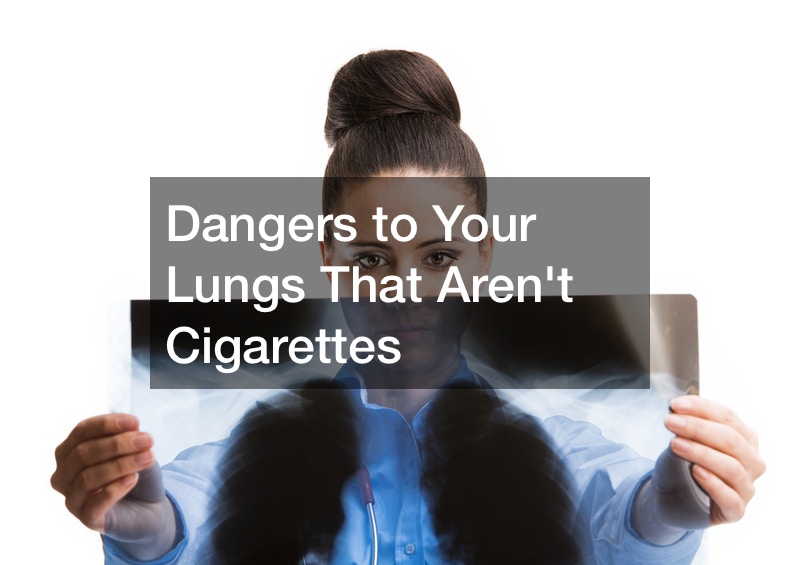
Millions of Americans have lung disease. The disorders grouped together as lung disease include allergic reactions, cancers, viral and bacterial infections, and lung damage due to toxins.
Some of the symptoms that might indicate lung disease include:
- Breathing difficulties
- Labored breathing or shortness of breath after short activity
- Lightheadedness or other signs that you are not getting enough air
- Difficulty performing strenuous activity or exercising
- Persistent or chronic coughing
- Coughing up blood
- Painful breathing
Smoking is the top cause of lung disease. But smoking is not the only cause of lung disease. Environment, communicable diseases, and even your job can contribute to your risk of lung disease.
Here are some dangers to your lungs that are not cigarettes.
Vaping

Vapes were originally promoted as a safe alternative to smoking. But vape manufacturers made this claim without much supporting evidence. Now that doctors have had a few years to examine the health effects of vaping, they have concluded that it poses substantial risks, including death.
Vaping is safer than smoking tobacco. But vaping still involves inhaling chemicals that do not occur naturally in the air. These chemicals are used to create vape juice or formed when vape juice is aerosolized by the vape. Moreover, many people use vape juice that is homemade, made by friends, or modified.
Doctors have connected two vape juice additives to about 60 deaths:
-
- Vitamin E acetate: This chemical is used as a thickener in vape juice. Doctors are unsure of the mechanism involved. But this chemical was found in the lungs of all 60 of the vape-related deaths.
- Tetrahydrocannabinol (THC): THC is the mind-altering chemical in marijuana. Some people who vape add THC to their vape juice to experience the effects of marijuana without smoking it. THC was found in over 80% of the patients hospitalized for vaping-related lung disease.
Vaping is still being investigated for its health effects. For now, the U.S. Centers for Disease Control recommends against using vape juice that contains either of these substances.
COVID-19

COVID-19 or the novel coronavirus deserves a category on its own because of its profound effects on the lungs and the rapidity of its transmission. After one year into the pandemic, scientists attributed over 500,000 deaths in the U.S. to the virus. Most of these deaths were due to lung damage.
To understand how COVID-19 kills, it is useful to describe the breathing process in the respiratory system.
-
-
- When you inhale, air containing oxygen is drawn into the lungs.
- The air fills small sacs in the lungs called alveoli. These sacs are covered with tiny blood vessels.
- The blood cells in the tiny blood vessels carry carbon dioxide from the body to the lungs. When they reach the alveoli, the blood cells release the carbon dioxide and pick up oxygen.
- When you exhale, the carbon dioxide is pushed out of the lungs.
-
In some individuals, COVID-19 damages the lungs. This damage occurs in a few ways including:
-
-
- Pneumonia: Fluid fills the alveoli. The fluid prevents the alveoli from taking in oxygen. Without oxygen, the body suffocates. Even if the pneumonia is not severe enough to cause death, it can lead to coughing, wheezing, and gasping for breath.
- Acute Respiratory Distress Syndrome (ARDS): The blood vessels that cover the alveoli begin to leak. This can completely cut off gas exchange between the lungs and the bloodstream. COVID-19 patients who develop ARDS usually require breathing support with a ventilator. ARDS can leave the lungs with permanent scarring.
- Infection: COVID-19 weakens the immune system. Bacteria can infect organs, including the lungs, causing inflammation and organ damage.
-
In most cases, a primary care doctor can treat a case of COVID-19. However, about 40% of patients with underlying conditions and 9% of patients without underlying conditions require hospitalization.
Infectious Diseases

The COVID-19 pandemic has raised awareness of the serious lung damage that can result from infectious diseases. But COVID-19 is not the only virus that causes lung disease.
Two other common infectious diseases can cause permanent lung damage or even death:
-
- Influenza: In a normal year, the flu causes anywhere between 20,000 and 60,000 deaths in the U.S. Most of these deadly cases happen in seniors or young children. Influenza, like COVID-19, can cause pneumonia. In people with weakened respiratory systems, this pneumonia can be deadly.
- Tuberculosis: Tuberculosis is a bacterial lung infection. The bacteria can be transmitted through the air, so tuberculosis can spread through jails, homeless encampments, and other places with poor sanitation and close living quarters. Tuberculosis can cause fatal lung damage. It can also lead to liver, kidney, and heart damage. Tuberculosis can be treated with antibiotics, but some antibiotic-resistant strains have developed.
Steps you can take to avoid infectious diseases include washing your hands regularly, maintaining a safe distance from others, and keeping up on your vaccinations. The TB vaccine is not routinely given to adults, but if you plan to travel to a country where TB is common, you might want to discuss the vaccine with your doctor.
The influenza vaccine is updated annually and doctors recommend that most healthy adults and children receive a flu vaccine. This is particularly true for people who have close contact with potentially sick people, such healthcare workers. If you are a doctor, nurse, dentist, or other healthcare provider, you should consider getting the flu shot early in the flu season to avoid becoming a vector for transmission of the virus.
Asthma

Particles in the air can trigger or even cause asthma. Asthma is an inflammation of your airways that can cause your airways to constrict. As a result, you could experience symptoms including:
-
-
- Shortness of breath
- Chest pain or tightness
- Wheezing
- Coughing
-
The causes of asthma can include:
-
-
- Exercise: Exercise-induced asthma is not necessarily caused by exercise, but by increased respiration brought on by strenuous activity. Exercise-induced asthma can be exacerbated by cold, dry air, so contacting an air conditioning contractor about a humidifier can reduce the risk of an asthma attack.
- Exposure: Exposure to chemical fumes or dust can trigger an asthma attack. Some occupations, such as automotive repair shop workers and construction workers are particularly prone to asthma attacks while on the job. Working in a well ventilated area and using breathing protection can reduce the risk of an asthma attack.
- Allergens: Allergens can trigger an asthma attack. Air pollution, smog, and smoke can also trigger an asthma attack. Staying inside when allergens are in the air can help avoid an asthma attack. If your home has allergens inside, consider installing HEPA filters in your HVAC system and hiring a company for smoke damage repair to reduce smoke particles in your home.
-
Toxic Chemicals
Exposure to toxic chemicals can cause lung disease and long-term damage to the lungs. Some of these chemicals directly damage the lungs. For example, chlorine used to sanitize pool water, can cause pulmonary edema, leading to death or permanent lung damage. Chlorine poisoning only happens occasionally due to leaking or damaged pool plumbing. But during World War I, chlorine gas was used as a chemical weapon.
Other chemicals only weaken the lungs and make them susceptible to tumors, pneumonia, and other lung diseases. For example, car painting technicians who fail to wear respirators and take other steps to minimize their exposure to aerosolized paint can inhale paint particles. These paint particles contain chemicals that damage the lungs. Moreover, the paint particles dry inside the alveoli and trigger an immune reaction. As a result, the lungs can become inflamed and the painter can experience chemical pneumonia as the alveoli fill with fluid.
Some herbicides and insecticides, like Agent Orange and DDT have been banned exactly for these reasons. These chemicals can lead to lung cancer, autoimmune disorders, and other terminal illnesses. Although a personal injury lawyer can pursue compensation for the costs of the illness, someone who suffers lung damage from chemical exposure can have their life substantially shortened. Unfortunately, many of these illnesses cannot be treated, regardless of the amount of money spent.
Lung Cancer
Smoking is the primary cause of lung cancer. But lung cancer can also result from other risk factors that you can control. Some of these risk factors include:
-
-
-
- Second-hand smoke: Tobacco smoke can also affect those around the smoker. Even though many cities and states have indoor clean air laws that prohibit smoking indoors, about 25% of Americans are exposed to second-hand smoke every year. This second-hand smoke is just as harmful to the lungs as direct smoke. But second-hand smoke is often inhaled in smaller quantities. Thus, the risk of lung cancer from second-hand smoke is lower than smoking.
- Radon: Radon is a radioactive gas that occurs when uranium naturally decays. Radon infiltrates homes through the ground. Since radon is heavier than air, it usually collects in basements. Some of the risk factors for radon in your home include poor ventilation, cracks in the foundation, and a location near uranium deposits.
- Toxic exposure: Chromium, silica, asbestos, diesel fumes, arsenic, and some pesticides can cause tumors to grow in your lungs. The incidence of lung cancer from these sources is lower because exposure to these chemicals is relatively low. But some of these substances are so dangerous that they can cause lung cancer after a few exposures.
- Radiation: Radiation exposure can increase the risk of lung cancer. People can be exposed to radiation through their jobs as miners, nuclear power workers, or radiology workers. People who have had a lot of x-rays or required radiation treatment for cancer are also at risk of radiation-induced lung cancer.
- Diet: Poor nutrition increases a person’s risk of developing all kinds of cancers. Although no studies have shown a direct link between specific foods and lung cancer, eating healthy foods and a balanced diet will reduce your overall cancer risk.
- Genetics: Unfortunately, some families have a higher risk of lung cancer than others. If you have a family history of lung cancer, you have a higher risk of lung cancer.
-
-
Physical Injury
Falls are the number one reason for visits to the emergency room. Accidents, in general, are the third leading cause of death in the U.S. The physical injuries that result from accidents can cause permanent lung damage.
Of the top ten types of accidents, six can directly affect your lungs:
-
-
-
- Falls from a height can break ribs. Broken ribs can puncture your lungs and cause them to collapse.
- Motor vehicle accidents can bruise or crush your chest.
- Drowning can result in permanent lung damage if you survive.
- Fire can cause smoke inhalation that can kill you or permanently damage your lungs.
- Choking can damage your airway even if you survive. Suffocation by carbon monoxide poisoning can lead to death or lung damage.
- Falling objects can pin you to the ground and prevent you from breathing.
-
-
Some ways to avoid physical damage to your lungs include:
-
-
-
- Use safety equipment while working. Whether you use respirators to avoid inhaling fumes or roofers harnesses to prevent falls, you should use your safety equipment at work.
- Learn first aid and encourage your family to learn first aid. Choking and drowning can be treated with first aid. The sooner you receive treatment, the higher your odds of surviving with minimal organ damage.
- Drive carefully. Over 90% of vehicle accidents result from driver error. Driving carefully substantially reduces your chances of being injured or killed in a car accident.
-
-
Lung damage can result from many causes besides smoking. Lung disease includes viral and bacterial infections, asthma, chronic obstructive pulmonary disease (COPD), physical lung damage, lung cancer, and toxic exposure. Fortunately, most of these diseases can be prevented.
Wearing safety equipment can reduce the risk of lung damage from chemical fumes and smoke. Reducing or eliminating the use of vapes can avoid popcorn lung and other lung diseases. Avoiding allergens can limit the risk of an asthma attack. And taking reasonable measures to avoid catching COVID-19, influenza, and tuberculosis will help you avoid pneumonia and other lung problems from diseases.



